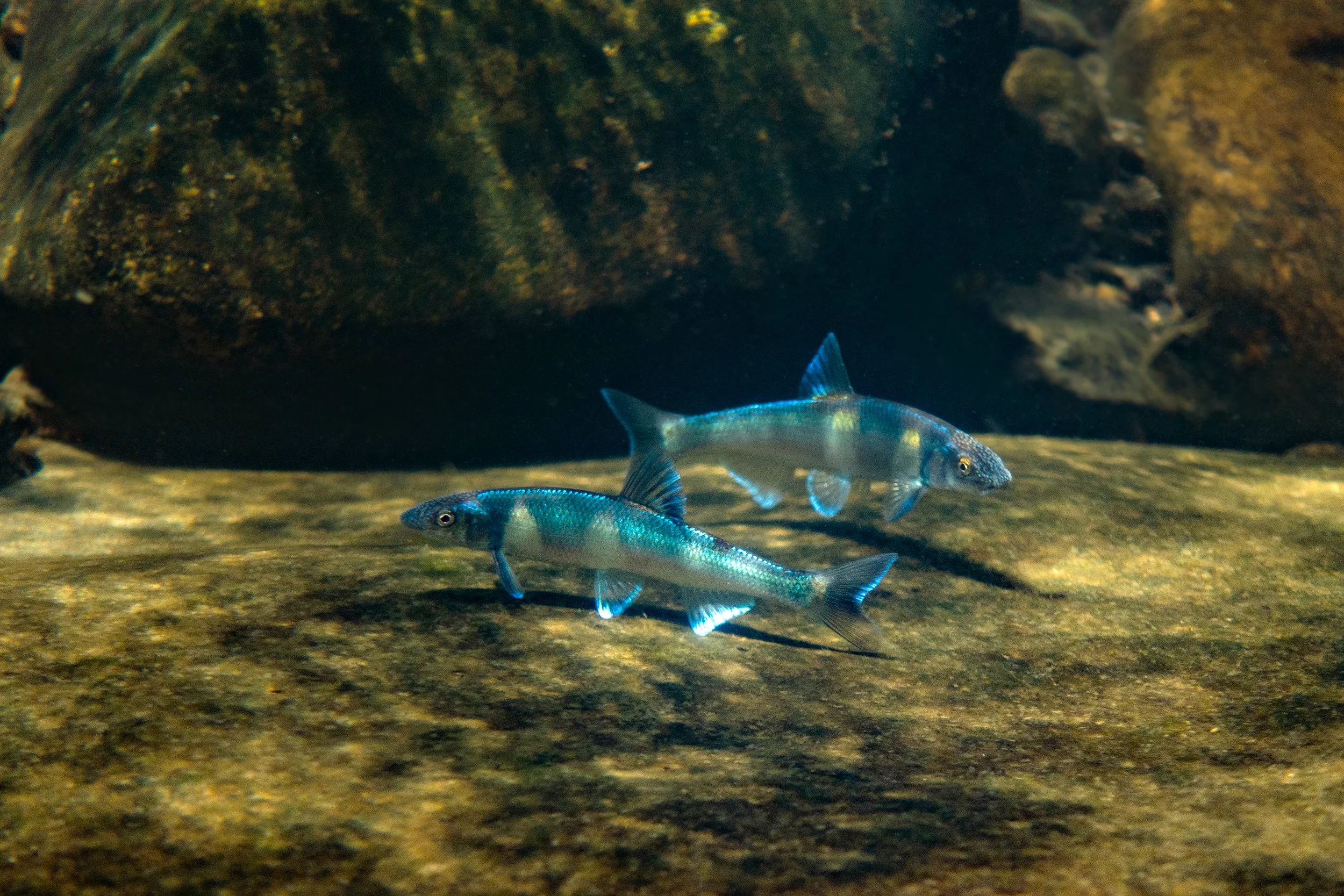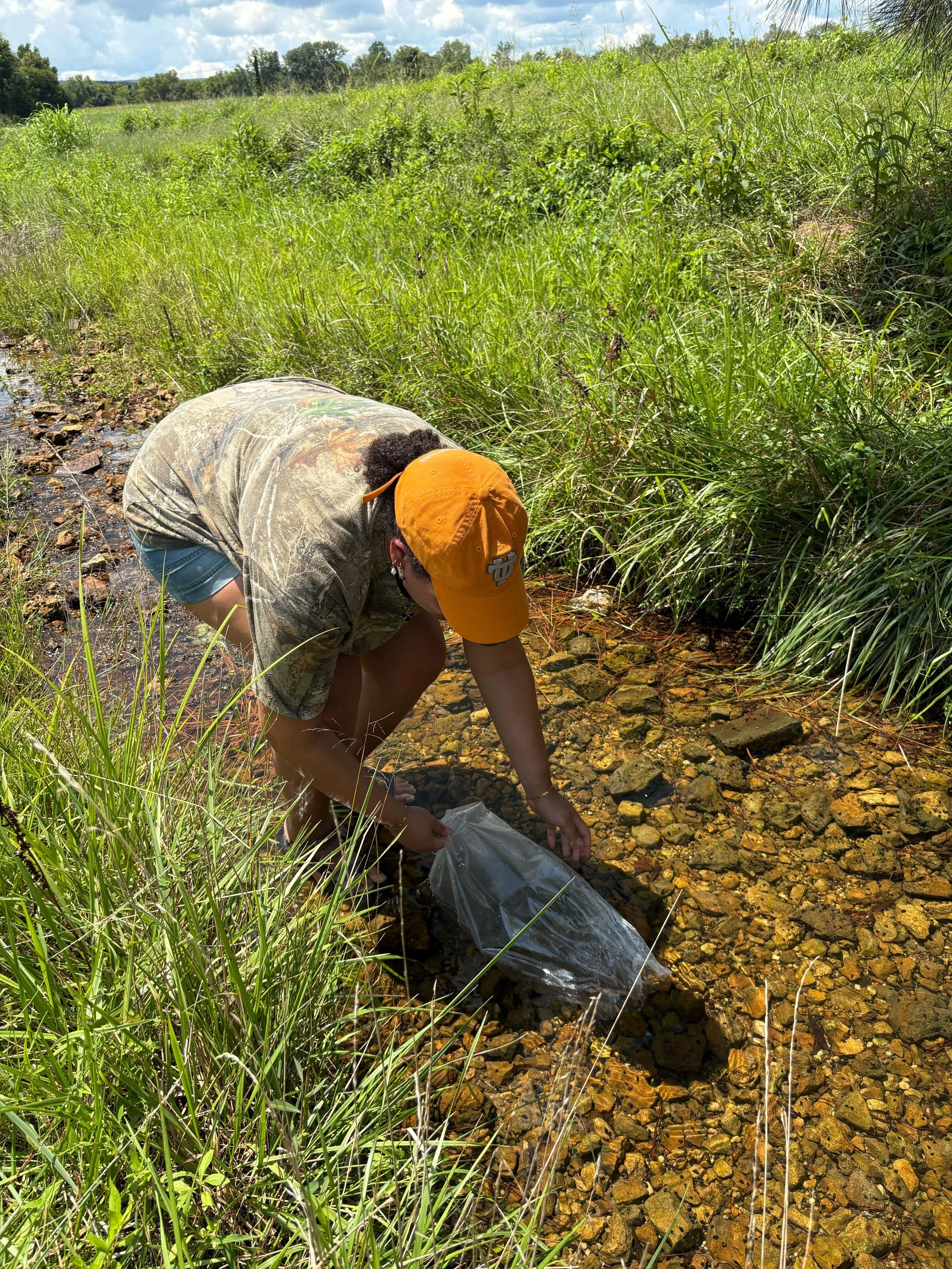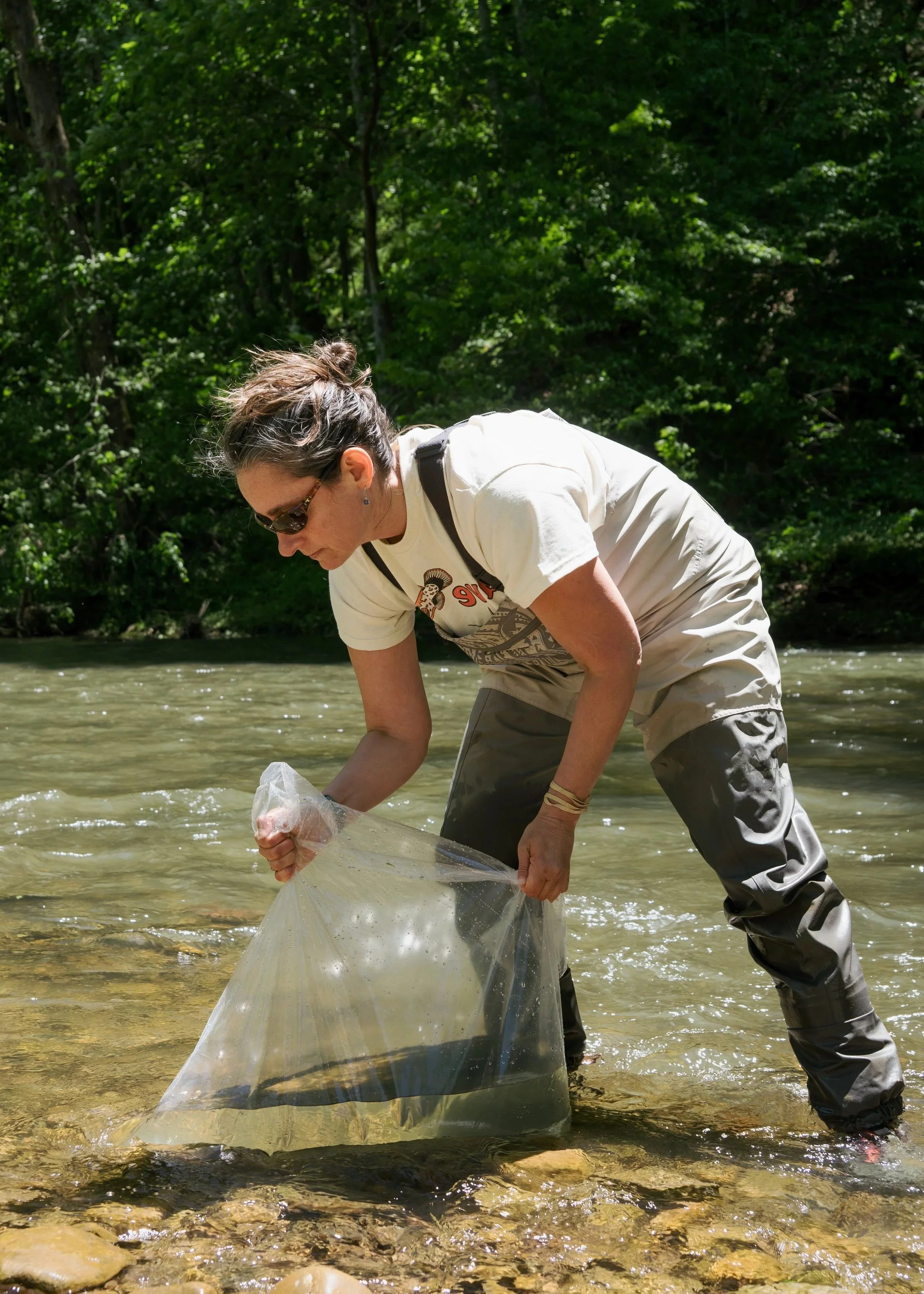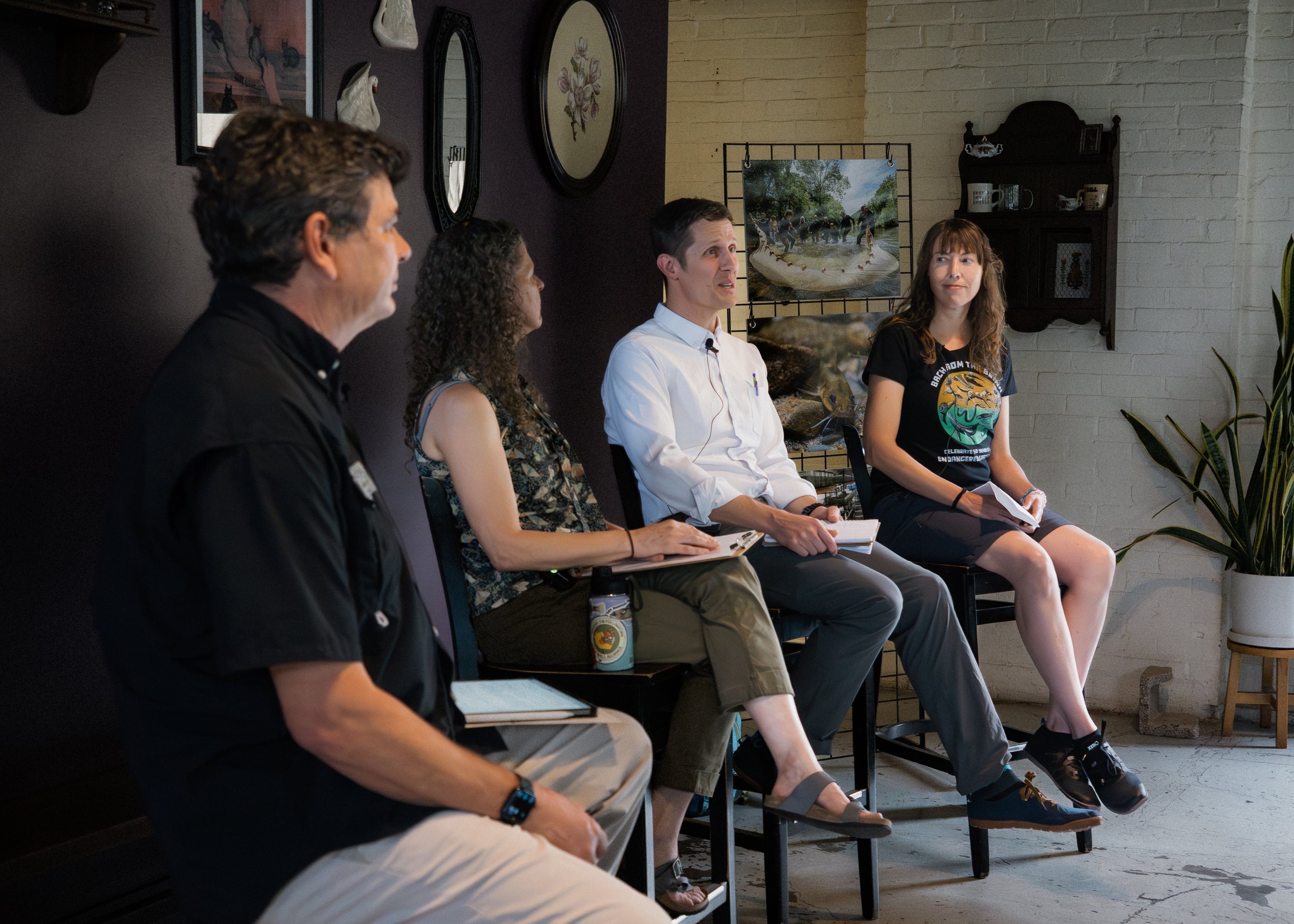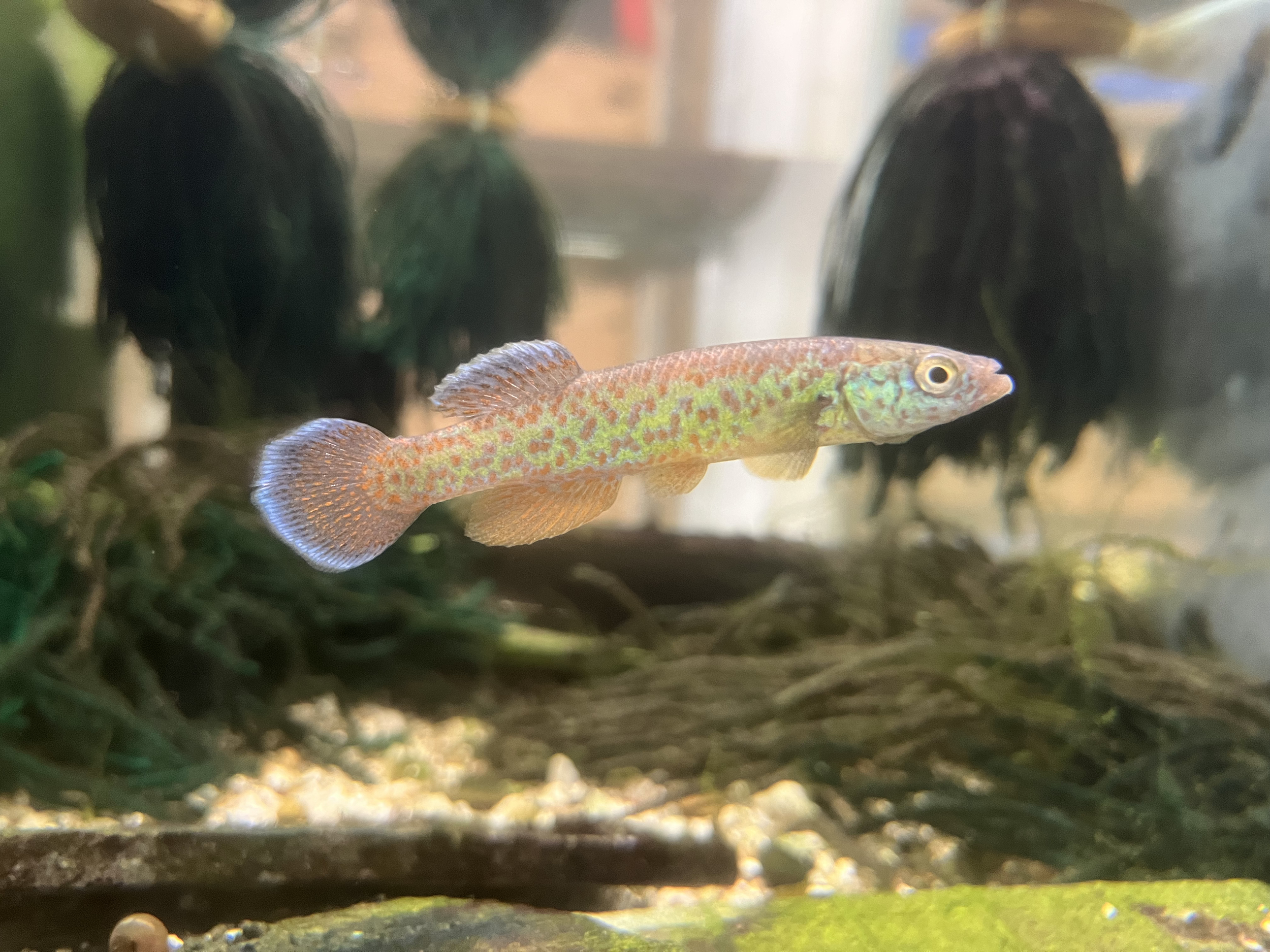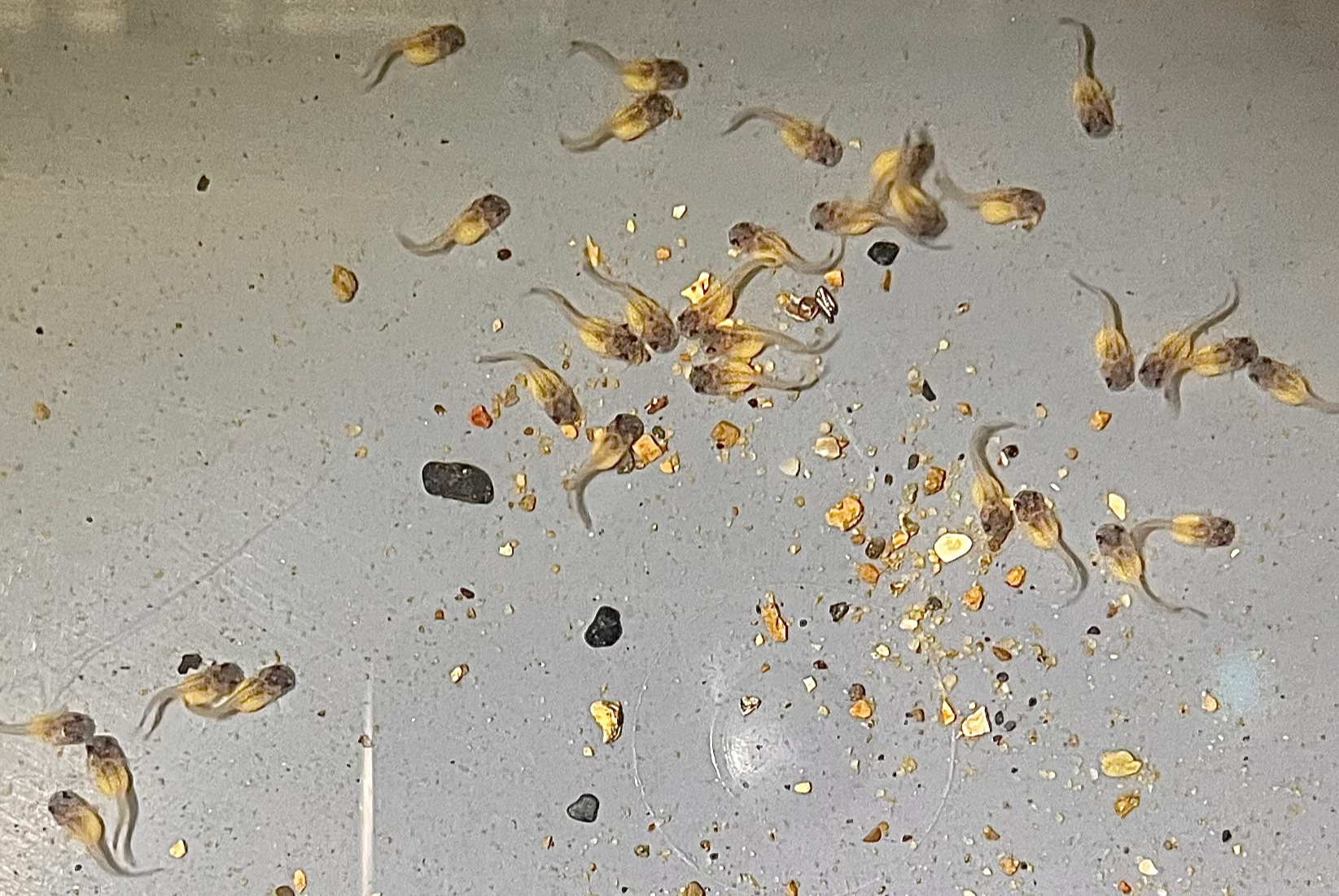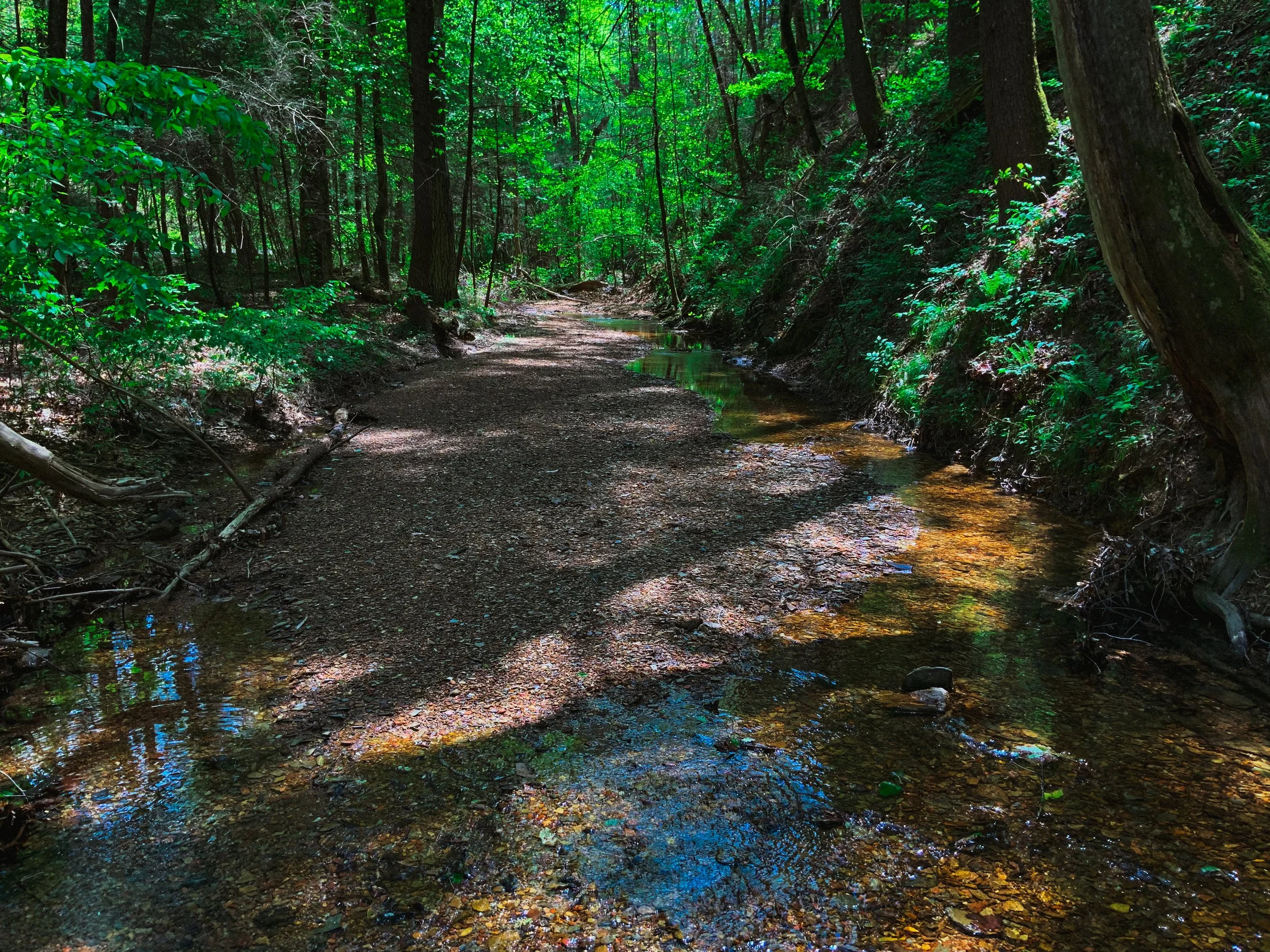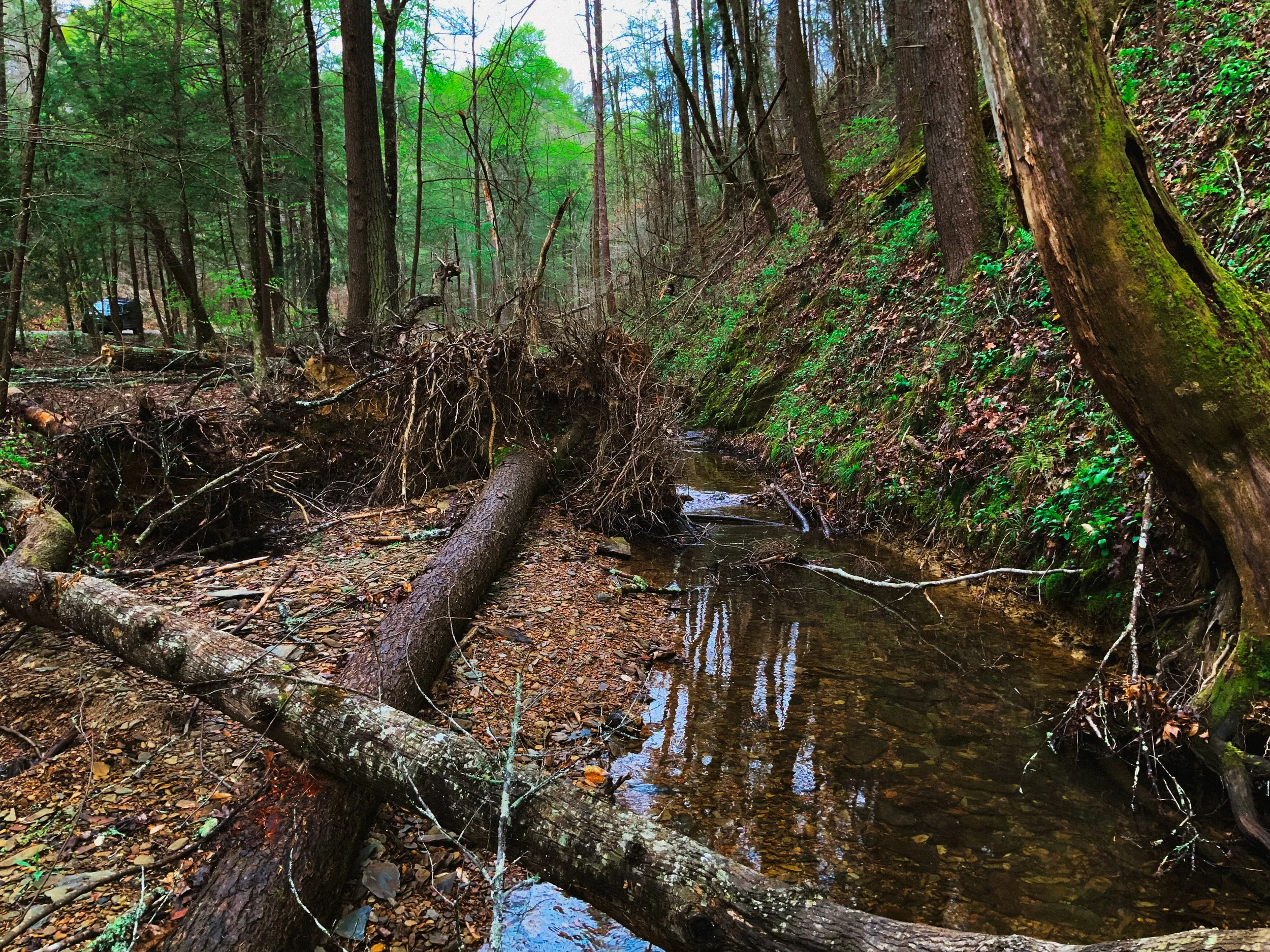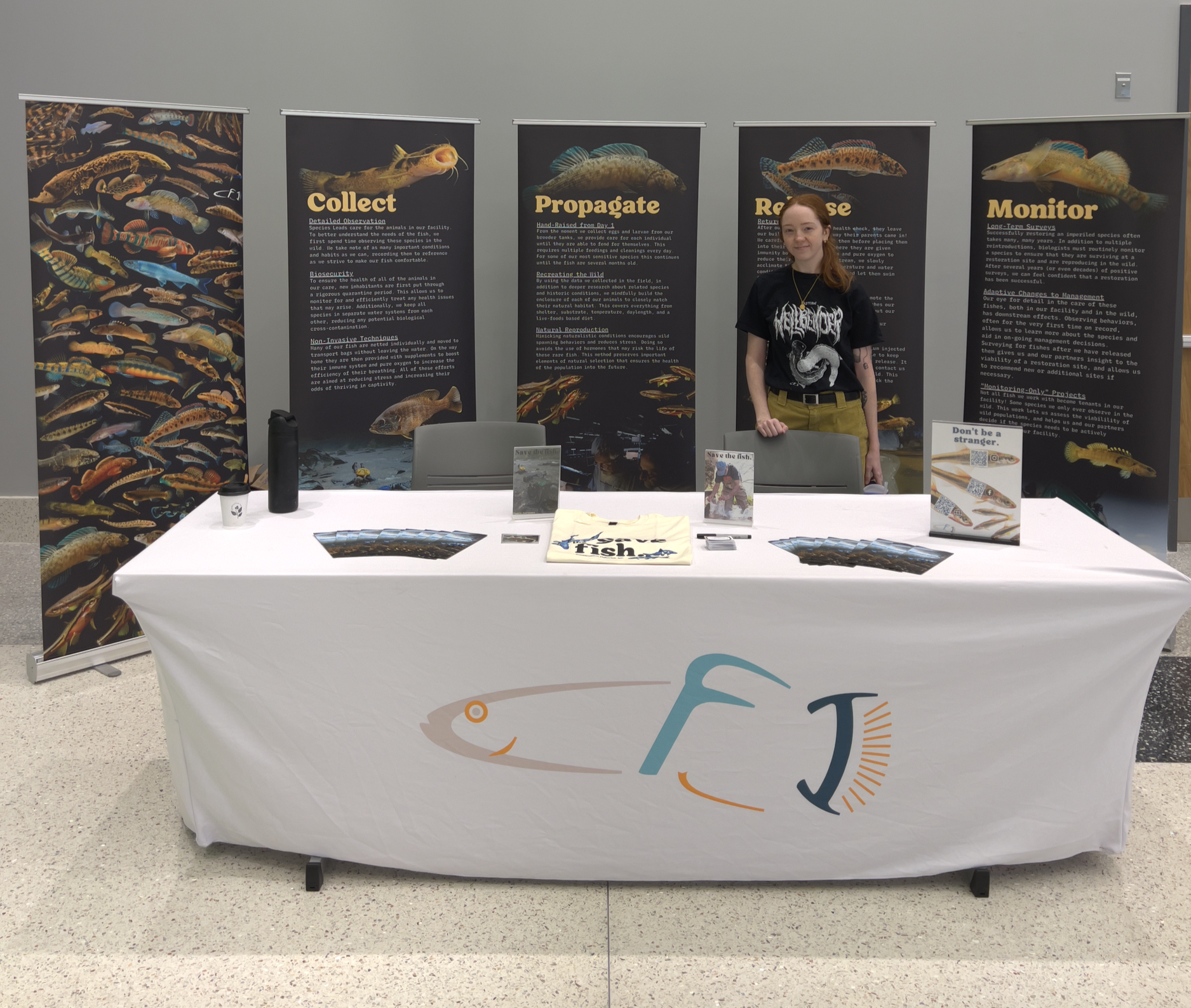Conservation Roundup: August 2025
Conservation Round-Up
Summer to Fall Season Transition
August is one of those tricky months because it feels like we should be getting ready for the fall season, but the fish say it’s still summer! There are a few species who have either just finished spawning or are close to it. Carolina Madtoms have been our most successful madtom to propagate in our facility! Careful observations led to a better understanding of their spawning behaviors, and we’ve been producing several hundred young for the last several years. Spotfin Chubs are one of our most prolific spawners, as minnows often are. Barrens Topminnows, one of the most endangered species in the world due to a plethora of local threats, lay their hardy eggs well into August. By the time we reach September all species will have tapered off, completing their spawning season for the year. That leaves us with the rest of the year to continue growing the young fish, making our way into our big “Release Season” when we introduce these fish to their native waters for the first time.
When spawning season finishes up, it opens up more opportunities for our biologists to snorkel in our local streams to survey for some of the species that we work with! We are hesitant to do much surveying during the spawning season when we may interrupt breeding rituals or accidentally uncover a nest. Thankfully by this point in the year we feel that it is safe to resume these field efforts.
Volunteer Program
We have a few announcements regarding our Volunteer Program!
While we typically open applications before every season, there will be no open applications for this fall or winter to join our program. We were fortunate enough to have many of our previous volunteers stay on or come back for our fall season, which filled up all available spots for the first time since we’ve been running this program. We’re so grateful for the time and dedication that these volunteers have shown us, and are thrilled that they would like to continue spending time with us!
The winter season, our shortest volunteer season (running from December through January), is logistically difficult. Especially when combined with the erratic holiday schedule. If we find ourselves with bigger winter projects requiring more hands than we have available, we may open up applications for this season again!
As an extension of our Volunteer Program, we have been working with the University of Tennessee to offer an internship-focused volunteer opportunity for students to apply a large amount of volunteer time towards course credit. This summer we brought on Izabella as an Assistant Conservation Biologist to test out this concept and we all really enjoyed it! She spent her summer working primarily with the Barrens Topminnow and the three lead biologists for that species. We hope to offer this type of opportunity again in 2026 and potentially include other local universities in this partnership as well.
We’re so grateful for everyone who has an interest in our Volunteer Program! Given all of these changes, our next volunteer applications will go live in early January 2026 for the spring season, running from February 2026-April 2026. Opportunities for a spring internship will be advertised directly through universities this fall, coordinating with spring semester advisement. We look forward to bringing on some new folks at that time!
Save the Date
September 29th - Hidden Rivers hosted by Tennessee Citizens for Wilderness Planning (TCWP) at the Grove Theater in Oak Ridge
We’re honored to have been featured in Freshwaters Illustrated’s Hidden Rivers documentary, highlighting the importance of conservation work right here in Southern Appalachia. If you haven’t seen it yet, don’t miss this opportunity! It’s the kind of film that stays with you long after the closing scene.
October 18th - Sturgeon Fest
Sturgeonfest is a yearly celebration of this magnificent, long-lived native species. Come on out to Seven Islands State Birding Park to get the chance to release a small sturgeon into the French Broad River!
November 8th-9th - Saint Tattoo Flash Tattoo Weekend
You asked, we listened! Our second Flash Tattoo Event at Saint Tattoo will be this November - for a whole weekend! Stay tuned for this year’s flash sheets.
Species Spotlight
Candy Darter, Etheostoma osburni
Did someone say candy?? Candy Darters are aptly named as the males showcase bright nuptial colorations that remind you of the tastiest flavors of skittles. They are a relatively large and robust darter, thriving in rocky areas of clear, swift streams. Candy Darters prefer cooler water and have a late spring spawning season. Like many darters they are substrate spawners, laying their eggs among the gravel. Unlike many substrate spawners that “broadcast” individual eggs in many places, Candy Darters will often lay their eggs in clusters! Their large eggs (for a darter) hatch out large larvae that grow at a surprisingly rapid rate considering the cooler temperatures they live in.
A species new to Conservation Fisheries, we first brought Candy Darters into our facility in late 2024 in anticipation for the 2025 spawning season. Since this was a first-time species, we inventoried their life history information which allowed us to draw on what we knew about the propagation of similar species. With this solid foundation and a little bit of tinkering as we went along, we were able to set up for ideal spawning and rearing techniques. The first year with a new species is often a bit of a toss-up and we allow ourselves some grace as we identify the intricate needs of the fish and make adjustments as needed. Well, 39 years of experience in adapting to change paid off! Our very first year spawning Candy Darters yielded us 90% larval survivorship. Many thanks to the Species Lead, Crystal, this year we’ve released 462 juveniles into the wild with about 475 planned to be released within the next few months!
The need for restoration of the Candy Darter comes from many angles. Part of its story isn’t dissimilar to many other darters, needing refuge and habitat remediation due to deforestation, mining, and incompatible local agricultural practices. However, there is a more unique issue impacting Candy Darters - hybridization with the more common Variegate Darter.
Variegate Darters are a sister species to Candy Darters. Historically their ranges did not overlap. A waterfall acts as a natural barrier between the two species, with the Candy Darter being upstream of the falls and Varigate Darters downstream. Somehow, likely due to “bait bucket introductions,” Variegate Darters have been established upstream into Candy Darter range. Not only do they compete for resources like food and habitat, they also hybridize. Oftentime when fish and other animals hybridize, the offspring of these two species are sterile, and the hybrids cannot reproduce and sustain themselves. Unfortunately the offspring between these two darters can reproduce, which blurs the lines between what we consider species. With the Candy Darter already being a listed species, hybridization adds even more complexity to the need for conservation and restoration of the species.
Given the initial success that we’ve had with Candy Darters, we’re hopeful that we can contribute to the future of this species and are grateful to have such an important part in strengthening their place in the ecosystem.
Community Outreach
In Our Hands Community Panel
Conservation Fisheries hosted a panel discussion at Remedy Coffee focused on policy changes and their potential impacts. The panel featured Sam Evans (Southern Environmental Law Center), Sara Gottlieb (The Nature Conservancy), and Tierra Curry (Center for Biological Diversity), and was moderated by the ever engaging Bo Baxter, Director of Conservation Fisheries. We had a great turnout and folks from the community got to ask questions, learn more about what’s going on, and find out how they can get involved in protecting the environment.
Musselfest
We participated in the first annual Tennessee River Musselfest, hosted by Keep the Tennessee River Beautiful at Seven Islands State Birding Park. Our table display highlighted the vital role mussels play in our watershed and their incredible ability to filter sediment from the water. The event featured interactive activities, talks, and displays from several of our partners, including the sponsors Keep the Tennessee River Beautiful, TWRA, TVA, Tennessee RiverLine, Seven Islands State Birding Park and Friends of Seven Islands, Legacy Parks, and Ijams Nature Center. Musselfest included the release of 200 native wavy-rayed mussels into the French Broad River, propagated at TWRA’s Cumberland River Aquatic Center.
Royal Explorers
We recently partnered with TVA to lead an educational outreach program for the Royal Explorers Camp hosted at Johnson University. Campers learned about the native fish species found in the French Broad River and got hands-on experience exploring macroinvertebrates. It was a fun way to connect kids with the biodiversity in their own backyard!
Season Highlights
Roanoke Logperch Delisting
Conservation Fisheries is absolutely thrilled to say that the Roanoke Logperch, which we first began working with in 2008, has been delisted from the Endangered Species List!
Roanoke Logperch were federally listed in 1989 when they were found only in 14 streams within their native range and were facing a multitude of threats including unregulated local agricultural practices, habitat fragmentation, impoundments, sedimentation, and other pollution. Over the last several decades there has been an effort to both restore native aquatic habitats and identify habitats within the Roanoke Logperch’s historical range in which they could be reintroduced. Historical ranges are streams in which a species used to be found but no longer reside, as well as streams in between historical ranges where it’s likely that the species had access to and which have suitable habitat. In addition to identifying these sites, many aquatic barriers such as small, unused dams and other passage-inhibiting structures were removed in order to allow aquatic connectivity between both the historical and currently populated sites.
Once sites with appropriate aquatic habitat had been identified and restored, propagation began in an attempt to populate these sites with Roanoke Logperch. Conservation Fisheries worked with Roanoke Logperch between 2008-2011 to develop propagation protocols for this species. So by the time we were brought on board later in 2019 to propagate Roanoke Logperch for restoration into these historical and restored sites, we were confident that we would have a successful contribution to the project. Since Conservation Fisheries began actively spawning Roanoke Logperch, over 1,700 of our fish have been released into these restored sites. We have been honored to be a part of this conservation effort!
Field Update
Barrens Topminnow Survey Revival
Given the abundance of threats that Barrens Topminnows face, a large collaborative network of biologists across the state of Tennessee is working to ensure the species’ survival. As a part of that effort, Conservation Fisheries did a survey on a handful of historical refugia sites for the species which had been previously surveyed by the Tennessee Aquarium. These refugia sites are necessary for restoration success since nearly all native sites are uninhabitable to Barrens Topminnows due to the introduction and presence of the invasive Western Mosquitofish. We were excited to identify a few sites where we believe this species could reside either very soon or after future site modifications. Until then, hundreds of Barrens Topminnows are thriving in our care!
Yellowfin Madtom Nest Collections
While most of the species we work with at Conservation Fisheries are spawned in our facility, there are a few species where it is more beneficial to collect the eggs or larvae from healthy, wild populations. One of these species is the Yellowfin Madtom! We snorkel to identify breeding habitat and will search those areas for healthy egg clusters, recently hatched young (called yolk-sac larvae since they have such a prominent yolk sac to feed on post-hatch), or dispersal larvae (larvae that have recently absorbed their whole yolk-sac and are now ready to feed from their environment). Each of these three life stages requires a slightly different collection method to ensure we collect them in a safe manner. Eggs in a nest are stuck together, so we can collect those as a cluster. Yolk-sac and dispersal larvae are already hatched, so we collect those as individuals! Dispersal larvae are more likely to, well, disperse, so we have to be quicker about collecting them. When collecting, we often get a variety of each life stage!
Blotchside Logperch Restoration
If you read our newsletter last quarter, you may remember a spotlight on Blotchside Logperch! After notably having a tough time producing them the last several years, we’ve had an extremely successful breeding season with this species! So much so that we were easily able to split up these young and release them into two different places - the Cheoah River and Citico Creek! As Blotchsides aren’t currently a federally listed species, we hope that this important restoration work will help to keep them off of the Endangered Species List altogether.
Partner Feature
The Forest Service is an agency of the U.S. Department of Agriculture and is the nation’s foremost federal forestry organization. The agency is a world leader in forest research, providing leadership in the sustainable management, conservation, use, and stewardship of natural and cultural resources on national forests and grasslands in the United States. The US Forest Service's mission is to sustain the health, diversity, and productivity of the nation's forests and grasslands to meet the needs of present and future generations.
Dedicated Forest Service employees manage the National Forest System, which consists of 154 national forests and 20 national grasslands covering 193 million acres in 43 states, the Virgin Islands, and Puerto Rico. The agency’s renowned fire management organization provides critical expertise in making communities and infrastructure safer. Moreover, the agency helps communities; state, local, and tribal governments; forest industries; and private forest landowners improve conditions in both urban and rural areas. In total, the Forest Service helps to steward about 900 million forested acres in the U.S., including 130 million acres in urban areas, which most Americans now call home.
Conservation Fisheries has been working with the U.S. Forest Service since our inception in 1986! Our first project, working with Yellowfin and Smoky Madtoms, included work in Citico Creek within the Cherokee National Forest. Since then we have partnered with them for many projects working on the recovery of several different species.
Given how large the Cherokee National Forest is, we have multiple monitoring projects to survey for many rare and non-game species in some of the more prominent rivers. Additionally, we currently propagate two species for restoration in the Cherokee National Forest - Blotchside Logperch and two populations of Tennessee Dace. Something really special about these two projects is that neither of these species are on the Endangered Species List, meaning that our work will directly impact their recovery in a way to keep them from ever being federally listed.
For the Tennessee Dace project, the Forest Service is actively doing habitat restoration to incorporate large woody debris into streams which will help to restore a more natural flow by creating stream sinuosity. This type of flow sparks sediment transport which creates pool habitats - conveniently a Tennessee Dace’s favorite place to be! Once that habitat is looking good Conservation Fisheries is clear to release our propagated fish and watch them thrive in this newly restored habitat.
We are so lucky to have partners that are as passionate about restoration work as we are! We make a great team and look forward to working with the Forest Service for years to come.
Gratitude
Contributions
Many thanks to all of the Conservation Fisheries staff members that contribute ideas for the newsletter as well as photographs of our field and facility work, especially of the beautiful fish that we have the pleasure of working with every day. Thank you as always to Joel Sartore, who has taken brilliant photographs of our species for years which appear constantly throughout our website and newsletters. Other photos and information in this edition come from our conservation partners, namely Keep Tennessee Beautiful (Kathleen Gibi) and the U.S. Forest Service (Matt Grove, and information from the USFS website). Information about outreach and events are thanks to Marley and Aster, and details about our Candy Darter project come from Crystal. Thanks to Bo, who has countless things to do as our Director but will always give feedback on the newsletter draft.
From our Team
As we move from our busy facility season to a busy field season, it’s comforting to know that there are folks out there who are interested in and dedicated to the important conservation work that we do. This support, along with our innate love for the fish, helps to push us through our peak working months with perseverance and appreciation. We’re so grateful for y’all.
- The Conservation Fisheries Team



